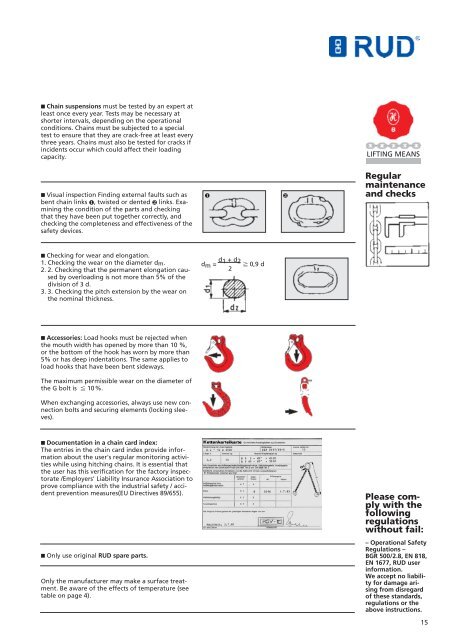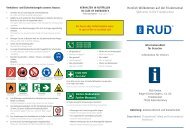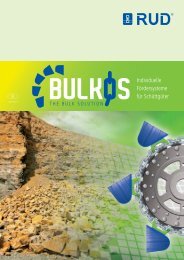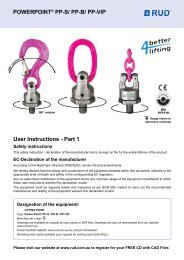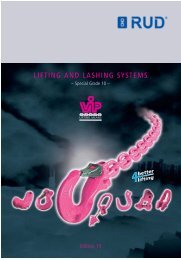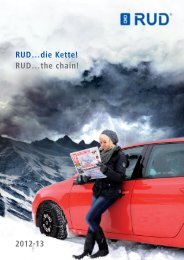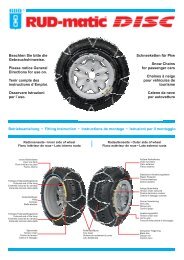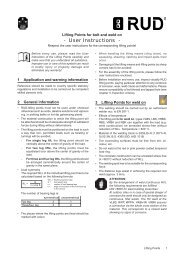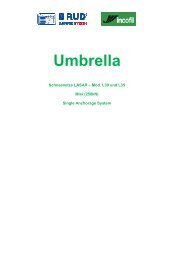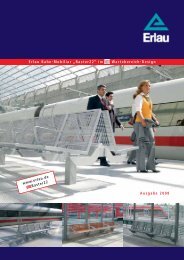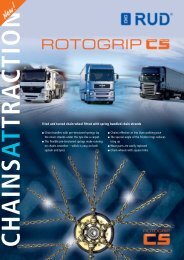Grade 80 - RUD
Grade 80 - RUD
Grade 80 - RUD
You also want an ePaper? Increase the reach of your titles
YUMPU automatically turns print PDFs into web optimized ePapers that Google loves.
� Chain suspensions must be tested by an expert at<br />
least once every year. Tests may be necessary at<br />
shorter intervals, depending on the operational<br />
conditions. Chains must be subjected to a special<br />
test to ensure that they are crack-free at least every<br />
three years. Chains must also be tested for cracks if<br />
incidents occur which could affect their loading<br />
capacity.<br />
� Visual inspection Finding external faults such as<br />
bent chain links �, twisted or dented � links. Examining<br />
the condition of the parts and checking<br />
that they have been put together correctly, and<br />
checking the completeness and effectiveness of the<br />
safety devices.<br />
� Checking for wear and elongation.<br />
1. Checking the wear on the diameter dm.<br />
2. 2. Checking that the permanent elongation caused<br />
by overloading is not more than 5% of the<br />
division of 3 d.<br />
3. 3. Checking the pitch extension by the wear on<br />
the nominal thickness.<br />
� Accessories: Load hooks must be rejected when<br />
the mouth width has opened by more than 10 %,<br />
or the bottom of the hook has worn by more than<br />
5% or has deep indentations. The same applies to<br />
load hooks that have been bent sideways.<br />
The maximum permissible wear on the diameter of<br />
the G bolt is � 10%.<br />
When exchanging accessories, always use new connection<br />
bolts and securing elements (locking sleeves).<br />
� Documentation in a chain card index:<br />
The entries in the chain card index provide information<br />
about the user's regular monitoring activities<br />
while using hitching chains. It is essential that<br />
the user has this verification for the factory inspectorate<br />
/Employers' Liability Insurance Association to<br />
prove compliance with the industrial safety / accident<br />
prevention measures(EU Directives 89/655).<br />
� Only use original <strong>RUD</strong> spare parts.<br />
Only the manufacturer may make a surface treatment.<br />
Be aware of the effects of temperature (see<br />
table on page 4).<br />
� �<br />
dm = d1 + d2 � 0,9 d<br />
2<br />
LIFTING MEANS<br />
Regular<br />
maintenance<br />
and checks<br />
Please comply<br />
with the<br />
following<br />
regulations<br />
without fail:<br />
– Operational Safety<br />
Regulations –<br />
BGR 500/2.8, EN 818,<br />
EN 1677, <strong>RUD</strong> user<br />
information.<br />
We accept no liability<br />
for damage arising<br />
from disregard<br />
of these standards,<br />
regulations or the<br />
above instructions.<br />
15


